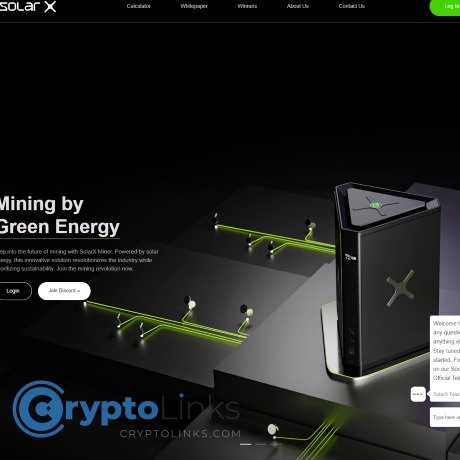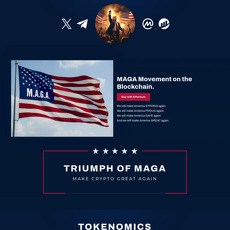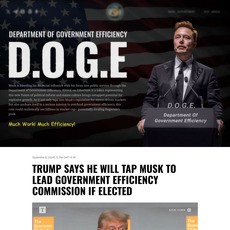SolarX Review
SolarX
solarx.ai
If your website is on the scam list and you think that you are not a scammer, contact us. After you provide us with all the proof that you are in Crypto World with good intentions, we will delist you. Usually, you get in this category because you are hiding your team, you have a bad reputation(you are tricking, deceiving, scamming people), and you haven't got a written project whitepaper or is a shitty one....
Their Official site text:
What is SolarXLast updated: 2023-05-11
The SolarX project is an innovative and eco-friendly approach to cryptocurrency mining that aims to use renewable energy sources to power the mining process. This is a significant development in the world of cryptocurrency, where mining has traditionally been associated with high energy consumption and negative impacts on the environment.
Key Benefits
One of the key benefits of the SolarX project is its potential to be used as a model for sustainable cryptocurrency mining. As the crypto industry continues to grow and mature, concerns about the environmental impact of mining are likely to become increasingly pressing. SolarX represents an innovative solution to this issue, providing a more sustainable approach to mining that can be replicated and scaled up over time.
Overall
Overall, the SolarX project represents an exciting development in the world of cryptocurrency and green energy, combining cutting-edge technology with a commitment to environmental sustainability. By leveraging renewable energy sources and the latest mining hardware, SolarX has the potential to be a game-changer in the crypto industry, paving the way for a more sustainable and eco-friendly future.
Reduce
By harnessing solar and green energy, SolarX can greatly reduce the carbon footprint associated with cryptocurrency mining, making it a much more sustainable and eco-friendly approach. The project's focus on using the latest, most efficient mining hardware also contributes to maximizing efficiency and minimizing energy consumption.
Solar X Mining Device
SolarX device is developed to use solar panels or other renewable energy sources to power the mining process, reducing the device's environmental impact and potentially lowering operating costs.
The mining device works by solving complex mathematical equations to verify transactions on a network and earn SolarX coins as a reward. This mining device is built on SolarX greenX chain and is compatible with the blockchain's consensus mechanism and follows its own network's rules for validating transactions between SolarX devices.
The use of renewable energy sources for cryptocurrency mining can help to create a more sustainable and eco-friendly industry and could potentially offer cost savings and other benefits for mining companies.
Reduced energy consumption: By using solar power instead of traditional power sources, the device could significantly reduce energy consumption and associated costs.
Environmentally friendly: Solar power is a clean and renewable energy source, which will help to reduce the carbon footprint of the mining process.
Increased efficiency: The use of solar power could increase the efficiency of the mining process, allowing for faster and more cost-effective coin generation.
Watt
Watt is a unit of power, which is a measure of energy per unit of time in SolarX mining. In the context of SolarX cryptocurrency mining, Watt will be used to measure the power consumption of mining hardware.
SolarX project will use Watt as a unit of measure for the power consumption of its mining hardware. Watt is a commonly used unit of power, which represents the rate at which energy is consumed or produced per unit of time. In the context of SolarX cryptocurrency mining, the power consumption of mining hardware is a crucial factor in determining its efficiency and profitability. By measuring the power consumption of mining hardware in Watts, the SolarX project can determine the energy efficiency of its mining operations and optimize its hardware accordingly.
Additionally, the use of solar power in the SolarX project's mining operations means that Watt can also be used to measure the energy production of its solar panels. By measuring the energy production of its solar panels in Watts, the SolarX project can optimize its solar panel arrays and maximize the amount of solar energy used in its mining operations.
Overall, the use of Watt as a unit of measure for the power consumption and energy production of mining hardware and solar panels in the SolarX project can provide a more standardized and transparent way of measuring the efficiency and sustainability of its mining operations.
Solar
SolarX mining device is a Solar-powered mining device that mines SolarX coins during the day and stores excess solar energy in a battery for use at night to mine. The mining device will be connected to a solar panel, an inverter, and a battery bank to function.
During the day, the solar panels will collect energy from the sun and convert it into DC electricity. The inverter will then convert this DC electricity into AC electricity that will be used to power the mining device. Any excess energy that is not immediately used by the mining device will be stored in the battery bank for use at night.
At night, or during periods of low solar generation, the mining device will draw power from the battery bank to continue mining.
SOLX
SolarX is an ERC-20 governance and utility coin that is used in SolarX mining devices. SolarX is the native coin of SolarX “SOLX” will be required to buy the mining device. SolarX will be used in real-life use cases and in the ecosystem of SolarX.
“SOLX” IS A UTILITY AND GOVERNANCE TOKEN THAT IS SPECIFIC TO THE SOLARX ECOSYSTEM.
“SOLX” is required to purchase the SolarX mining device, which suggests that it will have a role in securing the network and/or providing rewards for miners. “SOLX” will be used in real-life use cases such as purchasing items and paying for electricity charges for SolarX grid mini-Grids and recharging cars. This suggests that “SOLX” will have utility as a means of exchange or store of value within the SolarX ecosystem.
“SOLX” will be used to buy electricity and sell electricity, which suggests that the SolarX ecosystem will be involved in the energy marketplace or grid.
PAYING FOR THE SOLARX COMMERCIAL DECENTRALIZATION NODES WITH “SOLX”
It will be used on gaming platforms to purchase items and pay for cloud services. This suggests that Solx may have some role in incentivizing gameplay or creating a more immersive gaming experience.
Overall, $SOLX will have a variety of use cases within the SolarX ecosystem, ranging from securing the network to facilitating real-world transactions to enhancing mining and grids. It will be interesting to see how this token develops and how it is ultimately used within the SolarX ecosystem.
SOLARX GREEN CHAIN x POLYGON CHAIN
40% OF THE MINING DEPENDS ON SOLARX X CHAIN, 60% IS IN THE POLYGON CHAIN OF THE TOTAL SUPPLY
Having a portion of the SolX coin on the Polygon chain and the other portion on the SolarX chain, we are implementing a bridge or interoperability mechanism. This approach allows for the transfer of coins between the two chains.
To ensure the stability and continuity of the network, to avoid complete dependence on a single chain, like the SolarX chain. By distributing the coins between two chains, we are reducing the risk of disruption due to weather-related outages or any other potential issues specific to the SolarX chain. It is important for SolarX to have a sufficient number of active devices in different locations to maintain the validation process even in the event of weather-related outages, especially when the blockchain validation process depends on solar energy.
If the blockchain validation process is only dependent on a small number of devices in one country, and the weather in that country affects the performance of the devices, the validation process could be at risk of disruption. Requiring the sale of over 20,000 devices in different countries before releasing the blockchain is a strategy to ensure a sufficient number of devices and a diverse geographical distribution to mitigate the risks of weather-related outages.
Coins are minted on the receiving chain when transferred from one chain to another and burned on the sending chain, helping maintain a consistent coin supply and ensuring the integrity of the overall network. It provides a mechanism for users to seamlessly transfer and utilize the SOLX coin across both chains while mitigating risks associated with any potential disruptions.
By diversifying the network across multiple chains and implementing these mechanisms, we are enhancing the resilience and stability of the SOLX ecosystem, while still leveraging the benefits of renewable energy sources for mining on the SolarX chain.
SolarX, using renewable energy sources like solar or wind power to validate a decentralized chain, has the potential to significantly reduce the environmental impact of the blockchain industry while also promoting sustainable energy practices.
40% of the total supply of a coin is made available for miners to mine each year, and out of that 40%, only 10% is distributed to the miners, it means that miners will receive 10% of the 40% allocated for mining each year.
that there will be transaction fees in centralized exchanges, amounting to 3% of each transaction. In the mining pool, there will be a 10% fee, and these fees will go to the SolarX treasury
To summarize:
Miners will receive 10% of the 40% allocated for mining each year.
Transaction fees in centralized exchanges will be 3% of each transaction and will go to the SolarX treasury.
In the mining pool, there will be a 10% fee, and these fees will also go to the SolarX treasury
SolarX Coin Allocation
The total supply of SolarX is permanently fixed at 700 million coins, so the total supply will never increase above the 700 million mark. Similarly, the contract interface does not expose any token-burning capability, so the total supply will never decrease.
SolarX is fixed at 700 million coins and there is no token-burning capability, which means that the total supply will never decrease. This fixed supply can help to create scarcity and potentially support the price of the coin over time, as demand for SolarX increases.
Having a fixed supply also ensures that the SolarX ecosystem remains stable and sustainable in the long run. It also means that the SolarX team will carefully manage the distribution of coins to ensure that there is enough liquidity to support the various use cases of the coin, such as buying and selling goods and services within the ecosystem.
40%MINING280.000.000
8%TEAM56.000.000
5%MARKETING35.000.000
15%STAKE105.000.000
3%ADVISORS21.000.000
29%ECOSYSTEM203.000.000
Different Entities
Who /What are the different entities and names and how do they relate to each other?
SolarX group is a Web 3 company located in Dubai, best known for the crypto world and the new concept of mining.
SolarX coin will be the newest project of the company, and it's intended to build a better mining concept in crypto.
SolarX is the steward of “SOLX”, a legal entity that exists to administer the decisions of the SOLX DAO.
SOLARX is a decentralized governance organization that will make decisions regarding ecosystem fund allocations, governance rules, projects, partnerships, and more “SOLARXCOIN".
DAO membership is open to all “SOLARXCOIN” holders.
Foundation control and role
Does the foundation control the SOLX coin and/or the SOLARX DAO? If not, what role do they play?
The Foundation does not control the “SOLX” Coin or the “SOLX” DAO. The Foundation consists of an administrative board, which exists solely to oversee the decisions of the “SOLX” DAO, as well as a third-party project management team in charge of ensuring “SOLX” Coin DAO decisions are implemented. A decentralized autonomous organization (DAO) is the best way to give every member of the community a vote on important decisions, whether it’s a technical upgrade or a decision to fund a new idea.
However, the reality is that today a DAO cannot sign a lease or hire people or make merch, or do whatever the community decides to do on its own. The Foundation is responsible for the day-to-day administration, bookkeeping, project management, and other tasks that ensure the “SOLX” Coin DAO community’s ideas have the support they need to become a reality.
Foundation Board
How was the foundation board selected?
Certain members of the community that have strong operational experience were consulted on how to best structure the “SOLX” Coin DAO. Several of these members voiced their willingness to join the Board to oversee the decisions of the community and are committed to upholding and furthering the decentralization of the “SOLX” Coin DAO. The initial Board will serve 2 years
Other individuals
Will there be a chance for other individuals to join the board?
Yes, after the initial 2-year term, DAO members will vote annually to keep existing or appoint new Board members. “SOLX” Coin token holders (the DAO members) can also remove or replace a Board member at any time with a majority “In favor” vote.
Benefits
The benefits of SolarX cryptocurrency mining company that utilizes renewable energy sources such as solar power, are numerous. Here are some of the potential advantages:
Benefits of SOLARX
Zero Air Pollution: Unlike traditional power sources such as coal or gas, solar power does not produce any emissions or air pollution. This makes it a much cleaner and more environmentally friendly option for powering mining operations.
Zero Gas Fees: By using renewable energy sources to power its mining operations, a SolarX cryptocurrency mining company can eliminate the need for expensive gas fees on the blockchain.
Green Environment: By reducing the carbon footprint of mining operations, a renewable energy-based mining company can help to create a more sustainable and eco-friendly environment.
Free Electricity: If the mining company can generate more energy than it needs for its mining operations, it can potentially sell the excess energy back to the grid, generating additional revenue and potentially even offsetting the cost of mining.
Passive income: Mining cryptocurrency can be a lucrative business, generating a steady stream of passive income for the company and its investors.
Overall, SolarX is a cryptocurrency mining company that utilizes renewable energy sources that can provide a range of benefits, both for the environment and for the company's bottom line. By leveraging the latest technology and sustainable energy sources, such a company can help to pave the way towards a more sustainable and environmentally friendly future for the cryptocurrency industry.
SolarX Facility
President Joe Biden plans to invest $2 trillion in clean-energy initiatives over the next four years, with a loftier goal of making America a net-zero-emissions country by 2050. Just how much progress he can make remains largely up to the composition of Congress, but most analysts expect a much more accommodative Washington for green energy over the next few years.
Source:: "The NY Times. February 2021. “Biden Announces $2 Trillion Climate Plan.”
China has now committed to reaching carbon neutrality by 2060, putting the world’s biggest market for solar and wind power on the path to ramp up installations as it begins its next five-year plan.
Bloomberg New Energy Finance’s recent report shows that the sector will receive nearly $5.1 trillion worth of investment in new power plants by 2030. Given the anticipated spending spree in the sector, investors who choose to "go green" could see their holdings grow along with the demand for energy.
SolarX Farm
The energy transformation as a supply grid issue: Currently, large central power plants basically supply their immediate surroundings. In the future, more small SolarX mining devices, decentralized wind and solar generators will take on a greater load of the supply. This will lead to a new network architecture that may be less vulnerable to power outages than present-day grids, contrary to the fears of some
Wind Farm
As large power plants are replaced by multiple photovoltaic panels on roofs, and wind turbines on hills and offshore, we now believe that synchronization in a decentralized power grid may actually be easier than previously thought, as a grid with many generators finds its own shared rhythm of alternating current.
Solar and wind energy will help stabilize the power grid and cryptocurrency mining.
Renewable energies such as wind and the sun are set to become increasingly important in generating electricity. If increasing numbers of wind turbines and photovoltaic systems feed electrical energy into the SolarX grid, it becomes denser and more distributed. Therefore, instead of a small number of large power plants, it links a larger number of small, decentralized power plants supporting cryptocurrency mining.
Solar Farm
Cloud mining has so far been expensive. You accumulate just coins, but with the SolarX cloud mining facility, you mine coins and sell energy to the grid:
A SolarX electricity facility that powers the grid and does cloud mining, also known as a solar power plant or solar farm, will refer to a large-scale solar energy generation facility that feeds electricity directly into the power grid for widespread distribution to homes, businesses, communities and does mining producing coins for those who invested in SolarX facility.
SolarX power plants will typically consist of arrays of solar panels or photovoltaic (PV) modules that capture sunlight and convert it into electricity through the photovoltaic effect.
The electricity generated is then fed into the grid through inverters that convert it from direct current (DC) to alternating current (AC) for distribution to consumers.
Electricity Facilities
Solar electricity facilities powering the grid can have various sizes and capacities, ranging from small-scale SolarX mini grids installations to utility-scale plants that generate large amounts of electricity to meet the energy needs of a significant number of users. These facilities have several advantages:
The surplus electricity generated from the solar panels, which is not used for mining, can be sold back to the grid or to other consumers, creating a potential revenue stream. This can offset the energy costs associated with cryptocurrency mining and make the mining operation more sustainable and environmentally friendly by utilizing renewable energy sources.
Renewable energy: Solar power is a clean, renewable source of energy that does not produce harmful emissions, greenhouse gases, or pollutants, making it environmentally friendly and contributing to mitigating climate change.
Grid stability and energy security: Solar power plants can contribute to grid stability by providing a consistent and reliable source of electricity during peak demand periods, reducing reliance on fossil fuel-based power sources, and enhancing energy security.
Increased energy independence: Solar panels can provide a decentralized and independent source of energy for cryptocurrency mining operations, reducing dependence on traditional energy sources, and increasing energy resilience.
Cost savings: Utilizing solar energy can offset the electricity costs associated with cryptocurrency mining, potentially increasing profitability for miners.
Sustainable energy generation: Solar power plants do not deplete natural resources and do not produce harmful waste or byproducts, making them a sustainable form of energy generation.
Positive marketing and branding: Utilizing renewable energy for cryptocurrency mining can contribute to a positive image and branding for the mining operation, appealing to environmentally conscious investors and customers.
In general, solar energy objects that supply the grid and produce coins play an important role in the transition to a more sustainable and renewable future of energy production and crypto mining by providing clean electricity to the grid for widespread use. They contribute to reducing greenhouse gas emissions, promoting energy security, promoting economic growth, and adapting currency crypto to your life in a healthier approach. A solar green energy facility can be an asset for both mining cryptocurrency and generating electricity for sale through the grid.
Micro Grids
The production and distribution of electricity today still relies on energy-producing companies. A centralized power station generates and distributes energy to consumers through large energy transmission channels. Consumers are required to pay high prices for electricity bills if they want to consume the energy supplied by these power stations. High electricity bills, frequent power outages, irregular voltage supply, and other issues are some of the problems that consumers face, but they can do little about them. Therefore, there is an immediate need for decentralization and distribution of energy generation. Reducing carbon emissions remains one of the energy industry's most complex challenges daily.
Pollution
Large amounts of carbon dioxide and other pollutants are polluting the atmosphere, leading to unhealthy air and a dangerous atmosphere. Geopolitical relations have been heavily impacted, with few effective strategies developed to address this issue.
Energy companies also need to adhere to the rules of energy regulatory commissions and implement best practices to provide long-term benefits and improve the quality of life for consumers. On the other hand, consumers have also recognized the need for efficient energy methods, leading to a high demand for such devices.
To eliminate the need for a centralized energy station, SolarX can be used. SOLARX will build decentralized local energy supply sources and can connect neighboring households through a microgrid. Microgrids on the SOLARX platform can be developed to connect adjacent residences to form a local energy station.
A home with excess energy resources (such as a solar panel) can share the excess energy with another home that requires energy for consumption. Smart meters executed by smart contracts will record the energy supplied and consumed by the respective parties on the SOLARX platform (dashboard). This encourages peer-to-peer communication on the SOLARX platform, where participants can decide on the amount they want to pay, to whom to sell their excess energy, etc.
Optimize the cost of electricity
Implementing SolarX microgrids also helps optimize the cost and fair pricing of electricity. Furthermore, SolarX ensures that there is no unfair pricing and any fraud in the process since everything will be decentralized. This way, energy can be consumed and distributed more effectively and efficiently among others. This can provide a small but important step in indirectly reducing carbon.
One of the strengths of SolarX microgrids will also be the storage of electricity. The innovation of energy storage and sales to others by utilizing the SolarX platform will enter the electricity industry, which has great potential and has been used very little, almost not at all in crypto.
A SolarX-based energy storage and trading platform among consumers can provide transparent, secure communication for users for sharing energy resources and enable easy interaction.
The decentralized SolarX platform can be used to promote industries that actively support efficient energy innovations by investing heavily in the development of renewable energy sources. Consumers who use SolarX solar panels or other panels can share and trade excess energy with their neighbors (using SolarX microgrids as discussed above) and will also be rewarded with coins to encourage and expand decentralization.
GIS Mapping
SolarX by using Lidar and GIS mapping, SolarX will gather detailed and accurate information about the terrain, solar radiation, and environmental factors in a given area. This data will then be analyzed to identify areas that are suitable for solar crypto mining while minimizing the impact on the surrounding environment and communities.
Lidar
Using Lidar, SolarX will create detailed 3D maps that provide information on the height and slope of the land, as well as any obstacles that may be present. This information can be combined with GIS data to identify areas that receive sufficient solar radiation and are also suitable for solar crypto mining development.
The use of GIS mapping will also help SolarX to assess the potential impact of solar crypto mining on the surrounding environment and communities. By considering factors such as wildlife habitat, water resources, and cultural resources, SolarX can ensure that the development is conducted in an environmentally responsible and sustainable manner. The use of Lidar and GIS mapping by SolarX is a promising approach to identifying suitable areas for solar crypto mining development while minimizing the impact on the environment and communities.
Charging Points
The electric vehicle sector is promising for increasing energy security, economic opportunities, and improving air quality worldwide. It also strengthens the goals of SolarX in the EV world.
Before many electric vehicles (EVs) are integrated into the electric grid, an investigation and assessment of important parameters are required.
Decentralized charging network
The additional linear loads and EVs will be connected to the decentralized market. SolarXmini grid, many automotive companies have already invested in the electric vehicle sector; the market is growing. It is growing quickly, and it is growing everywhere.
Driven by a decarbonization challenge that most leading countries are now taking seriously, global sales of electric vehicles will continue to accelerate in 2022. Looking at the first five months of the year, over 3.2 million new plug-in vehicles were registered worldwide.
The growth in electric vehicle registrations in Europe, where numbers are accelerating much faster than anywhere else since 2019, can be attributed to the stimulating measures introduced by many European governments. Large markets have also introduced tax benefits and subsidies, which have contributed to the increase in sales.
Sources: EV Volumes & Global EV Outlook
The biggest barrier to the adoption of electric vehicles remains the limited availability of charging infrastructure, but the more electric vehicles there are on the road, the greater the need for more charging points. SolarX aims to provide everyone with this opportunity in the future and to make it decentralized. In 2021, there were over 376,000 publicly available EV chargers in Europe, and by 2025, it is estimated that there will be over 1.3 million charging stations accessible to the public. The number should further increase to 2.9 million by 2030.
Source: EV Volumes
Solarx Grids
That's why SolarX plans to create the largest decentralized charging network, powered by SolarX grids (mining grids)
Vehicle-To-Grid (V2G) infrastructure
For the general design and study of vehicle-to-grid (V2G) infrastructure, this work also offers an overview of the representation of electric vehicles in different energy-efficient models and their categorization during network connection. The approved methodology for energy-efficient models includes life cycle emissions, economics, intelligent charging, real-time optimization, EV resource modeling, and a support vector machine (SVM) based method. This work positively impacts the integration of EV fleets and electric mobility in general, as it critically examines the influential parameters and challenges. This classification depends on the essential parameters at the forefront of EV network integration research. This review is a solution to increase network stability regarding new EV models. With the advanced development of electric motors and renewed battery technology models, cars with longer ranges are now available in the market. This document investigates the limitations of EV network integration and analyzes different EV models to facilitate network stability for a decentralized market.
SolarX Mini-Grids
Distributed decentralized generation sources (SolarXmini grids) are energy generation sources closer to consumer environments; they allow consumers to use renewable energy (RE) sources locally, thereby reducing maximum demand and losses on long-distance transmission. The paper summarizes the role of SolarXmining grids in meeting the requirements for clean and efficient energy locally.
The systems to fully exploit the advantages of implementing SolarX mini grids shortly, through the benefits, case studies of other countries, application, and economics of solar mining grids, can analyze and meet energy requirements in remote villages with renewable energy sources. The figure presents important advantages of decentralized generation for rural electrification.
Solarx decentralized grid and mining SolarX coins can be used to recharge electric vehicles in a more sustainable and cost-effective way. One way this can be accomplished is through the use of blockchain technology, which allows for peer-to-peer transactions and can help reduce the need for intermediaries.
In SolarX decentralized grid, energy is generated and distributed by multiple sources, such as solar panels, wind turbines, and batteries, which are connected through a SolarX grid (or SolarX mini grids). This allows for more efficient and flexible use of energy resources, which can be harnessed to recharge electric vehicles.
Mining coins of SolarX will be used to incentivize the production and distribution of renewable energy, which can then be used to recharge electric vehicles. Miners will earn coins by generating energy from renewable sources, and those coins could be used to purchase energy to recharge electric vehicles.
Planning trips with smart connectivity to find the location of charging stations is a viable solution for this. The demand for charging stations will rise due to the increase in electric vehicles. Consumers are opting for the ease of charging points and fast charging is preferred.
Overall, the use of decentralized grids and mining coins of SolarX can help create a more sustainable and efficient system for recharging electric vehicles.
Net Metering
Small wind turbines will be used in residential settings to directly offset electricity usage using net metering. Net metering allows customers to receive coins for excess electricity generated by their wind turbine that is fed back into the SolarX grid. These coins can then be used to offset the customer's electricity bill, making small wind turbines a cost-effective way to generate renewable energy for residential use.
In addition to offsetting electricity usage, small wind turbines will also be used to mine cryptocurrencies. The energy produced by the wind turbine will be used to power SolarX mining device, which will generate income by validating transactions and creating new blocks in the SolarX green chain. This can potentially provide additional revenue streams for homeowners and help promote the use of renewable energy sources. Distributed wind energy installations are common at, but are not limited to, residential, agricultural, commercial, industrial, and community sites, and can range in size from a 5-kiloWatt (kW) turbine at a home to a multi-megaWatt (MW) turbine at a manufacturing facility. Distributed wind energy installations are either connected to the customer side of the meter to meet the on-site load, or directly to distribution SolarX micro grids to support grid operations or offset large loads nearby. Distributed wind energy installations are defined by technology application, not technology size, but are typically smaller than 20 MW.
Implementing distributed energy storage (DES) systems in households and their connection to the grid according to standards will be a solution for decentralized distributed energy systems. DES balances demand and generation and increases the reliability of renewable energy loads connected to the grid.
Solar X Grid(SG)
SolarX Grid (SG) system is an integrated system that optimizes the efficiency, reliability, control, quality-of-service, and stability of power transmission and distribution via distributed computing technology with the most autonomous and adaptive communication infrastructure. It has self-healing capabilities. During crisis situations of the power outage, all the electric utilities will operate in a reliable, effective, and coordinated manner. Proper regulation and load leveling in the energy market are essential as new technologies in EV charging and renewable energy sources are attached to the power grid, which will act as additional loads in this situation. Smart grids provide an effective infrastructure for the regulated exchange of power, as well as the secure flow of information or data between the utilities.
Smart Charging Schedule Strategy and Quadratic Optimization Model
Smart Charging Schedule Strategy and Quadratic Optimization Model for EV Connected to Grids
The smart charging strategy is very efficient, and it enhances the reserve capacity of power in electric grids to maintain load leveling. Selecting a suitable optimization method is a viable solution to lower the charging cost in EVs. Without the help of smart charging, integrating the fleet of EVs into the grid may result in disadvantages, as there will be an additional load on the electrical utilities which are presently managing the load leveling and regulation. By smart charging, EVs can be scheduled to be charged automatically in off-peak times, and active power support to the grid can be made available during peak hours. A new SolarX computing-based method implemented on SolarX-grids will serve the functionality of smart charging easily. For all optimization strategies, for charging there exists a problem statement for the mathematical model. Using a smart scheduling strategy, the objective function for optimization can be initialized. In general, mathematical notation, the minimum load in the power grid is: min(P2grid)
Where Pgrid is grid power is denoted in Pload profile is the everyday power demand of a region/area without charging power for EVs, and Pcharging is the charging power of EVs.
Charging
Charging during off-peak hours will reduce the electricity bills to a much lower amount, and also ensure grid stability and reduce the power demand on the consumer’s end .The quadratic programming approach also ensures a minimized cost of charging schedule and maintains a predefined SoC of EV battery, even after allotting power to different utilities in the grid [224]. 7.4.2. Real-Time Optimized EMS Model for Electric Vehicles with Smart Charging Modes in the Power Grid
Real-Time Optimized EMS Model
Real-Time Optimized EMS Model for Electric Vehicles with Smart Charging Modes in the SolarX Power Grid
As electric vehicle charging stations are designed and implemented at a faster pace than ever before, the reliability of the grid must be optimized by energy management systems (EMS), and cost-effective smart charging modes are to be utilized in V2G infrastructure ... The SolarXmicrogrid consists of a network of different loads like dynamic loads, PV loads based on maximum power point tracking, and EV charging stations, etc. Four EV charging modes with different user options are suggested in this EMS model, including energy/cost efficiency or ultra/fast charging. The dynamic programming in real time is analyzed to optimize the charging of EV batteries in ECO and V2G modes. This model formulates the cost function and studies the characteristics of EV battery charging parameters like the state of charge (SoC), depth of discharge (DoD), etc. The effect of V2G systems on the lifespan of EV batteries depends on battery degradation parameters and the total cost of ownership of different EV charging modes.
EV users have the option to select different charging modes, and EMS communicates to converters through a communication channel; real-time battery information is required for energy management. Illustrates four EV modes of charging, denoted as ULTRA, FAST, ECO, and V2G with power from the grid as PU, PF, PE, and PV2G. The function of EMS is to measure the power grid parameters and transfer the individual charging signals based on an optimization algorithm.
Energy Management System
The power balance Equations (2) and (3) of the arrangement are written as:
The resulting power between demand and generation is:
where Pgrid is grid power, Pnet is overall net power in V2G, PL is the power of additional loads, PPV is power from renewables, and PEVm is the overall power for the EV Fleet. ULTRA mode charging is for users with high priority, and it is for a shorter duration with demand not exceeding the saturation value. Here, a maximum permissible power charger is supplied. The FAST option is available to those who do not wish to spend as much as ULTRA mode, and priority-wise, it is less than ULTRA mode. No prediction data is available in this mode. ECO mode is for users with minimum cost and charging, with lower priority than previous modes. V2G mode has complex controls, and it satisfies both the grid and the EV battery. The predicted data of energy flow is taken into account, and this mode supplies power to other vehicles when ULTRA/FAST charging requests are not handled by the SolarX microgrids. When energy demand reaches a saturation point, higher priority modes are only enabled by EMS optimization.
Aggregated EV Resource Modelling for Load leveling and Regulation in Power Grids
Energy Security
Energy security for the long term is an essential element for a sustainable future in growing transportation consumption. A fleet of EVs is a significant energy resource for the power grid as vehicle to grid (V2G) and grid to vehicle (G2V) modes of battery charging will increase generation adequacy and provide flexible energy storage in the order of megaWatts. The model suggests a method to determine the bi-directional storage capacity of electric vehicles, and to enhance the voltage regulation of the grid. The standards in charging and discharging directly influence the voltage regulation of the grid. Through this scheme, notable revenue can be expected from a long-term energy capacity commitment.
EV scheduled charging using V2G reduces charging costs and emissions. A centralized charging scheme would allow more EV integration into the grid. An aggregator is an entity that controls a large fleet of electric vehicles and is the reason for integrating EVs into the power grid to balance the load and generation. The performance parameters in the charging and discharging stages are monitored using algorithms, and minute-wise energy storage capacity of the deregulated electricity market is analyzed, keeping constraints like arrival, departure times, travel and parking duration, etc. By the momentary fluctuation of energy data observed between power supply and demand, an accurate system-wide frequency is stabilized.
The grid regulation has two modes, regulation down (RD) and regulation up (RU), where regulation up occurs when the demand exceeds supply, and regulation down occurs when supply surpasses demand, to nullify the grid imbalances momentarily. The charging/discharging power, trip distance, and arrival patterns are several parameters that influence RU and RD. The grid regulation depends on the availability of vehicles, as well as the expected mileage of the available EV aggregation at various charging places.
A Block diagram that represents the power scheduling activity by an aggregator. The input stage involves collecting data on vehicle information, like fuel economy, vehicle capacity, arrival timings, driving mileage, etc. The information is given to data acquisition, which analyses and computes the charge and discharge energy storage capacity of electric vehicles available at various stages of parking. The G2V and V2G power selection constraints include vehicle capability, available parking, charging infrastructure, etc. Different ancillary service markets are committed to the output energy storage capacity via aggregated connected channels.
Hence, apart from improving grid dependability, the model also analyses the coordination of grid connection with EV aggregation, thereby increasing opportunities in the competitive deregulated electricity market for new EV integration also [235]. The simulative model for instantaneous power scheduling (minute-wise) helps to attain storage capacity via a large fleet of EVs. It also presents wide opportunities for many EVs in this network and enhances the regulated capacity commitment of the grid.
An SVM-Based Model for Mitigating Power Quality (PQ) Disturbances in V2G Infrastructure.
Power Disturbance Mitigation
As electric vehicle charging technology is advancing to smart techniques, power disturbance mitigation is also an important parameter to be considered when the electric vehicle is connected to charging stations. Moreover, electronic power components in the vehicle, as well as the charging station, generate more PQ disturbance, which will significantly affect the EV battery life if it is not compensated on time. Figure 12 denotes a supervised machine learning algorithm-based model, i.e., for the categorization and analysis of independent and combined PQ disturbances, the support vector machine (SVM) models can be utilized in EV charging and discharging. The detection, classification analysis, and regression of performance parameters in EV charging can be easily computed by SVM. The important advantage is that the most promising and probable PQ disturbance can be sorted out, and it can be analyzed and mitigated separately with SVM models.
When a large fleet of vehicles is considered, the PQ disturbances in the system will become significant, as many different non-linear loads are present in the grid. Initially, signal processing techniques were required for diagnosing PQ disturbances by Fourier transform (FFT), discrete wavelet transform (DWT), wavelet packet transform (WPT), etc. Out of these techniques, generalized empirical wavelet transform (GEWT) has gained more significant attention due to its simpler adaptive filter design.
The power signal for charging has a fundamental frequency component, and it is decomposed into mono-frequency components by GEWT. These methods adopted are computationally less expensive when compared with conventional approaches. The SVM model processes the linearly inseparable input data so that a kernel function K (ui; uj) is used to create a high-dimensional space feature. A separate complete analysis of PQ disturbance is possible by using the SVM model with GEWT. It is observed that the combined detection of PQ issues reduces the overall accuracy. Many SVMs are employed for PQ analysis in power grids, and separate SVMs are assigned to detect and analyze single disturbances. The signals generate fundamental frequency variations of the order of ±0.25 Hz at various phase angles. Due to the computational efficiency and adaptiveness of GEWT, it is also selected for evaluating non-stationary signals; hence, SVM-based PQ analysis.
GPS Technology
SOLARX GPS technology will be used in conjunction with decentralized SolarX charging stations to provide a more efficient and convenient way to recharge electric vehicles. Decentralized charging stations can be in various locations, such as Homes, parking lots, shopping centers, and public areas, which can be identified and located using GPS technology.
GPS
With GPS, electric vehicle drivers can locate and navigate to the nearest decentralized charging station and use their mobile devices to initiate the charging process. This will be accomplished through a mobile app that allows users to search for available charging stations, reserve a charging spot, and pay for the charging session using a SolarX Coin.
Additionally, GPS technology can be used to optimize the use of energy resources and reduce the cost of charging electric vehicles. By monitoring the location and charging patterns of electric vehicles, charging stations will adjust their output to match demand, reducing the strain on the grid and ensuring that energy is used in the most efficient way possible.
Overall, the combination of GPS technology and SolarX decentralized charging stations will help to create a more sustainable and efficient system for recharging electric vehicles, while also providing a more convenient and accessible experience for drivers.
The Benefits Of Electric Vehicles
Part of the review, the benefits of electric vehicles, such as reduced toxic emissions, and lower fuel, operating and maintenance costs, were basically an insight into the challenges and barriers in EV adoption to the decentralized market. In general, the definition of decentralized electricity markets in association with DERs was discussed; moreover, several EV models based on energy performance and influential parameters were categorized, along with case studies of a few countries. The classification of electric vehicles as different models was done based on critical parameters which draw more attention in the field of EV research. As EV technology is growing so fast, the ability of grids to automatically stabilize the necessary constraints will help the V2G ecosystem to add more EV fleets into it for charging, thereby reducing energy anxiety. This work is mainly concentrated on the generalized structure of decentralized markets and the impact of EV fleet integration into the grid. Hence, the renewable energy sources (RES) integration and other load impacts on the grid were not discussed in detail, but notable references were included.
The contributing parameters like peak shaving, valley filling, and load leveling gain importance for grid stabilization during V2G, and sufficient research data on this has to be included for different EV models. The above issues can be considered as the future scope of SolarX company.
The literature review is unbiased and conclusive in its assessment that it will bring solutions and insight to the current barriers to the implementation of EV in the power grid. Integrating nonlinear intermittent loads, such as renewable energy sources, into the grids and the potential benefits of the models discussed are worthy of further research. The advancement of technologies in the field of electric vehicles and decentralized markets will make it possible to make our lives easier and safer by using clean energy. We firmly believe that this evaluation has a positive impact on EV fleet integration and electric mobility.
SolarX AI
SolarX Smart grids will use AI algorithms to automatically detect weaknesses in power supply systems, identify areas where energy efficiency can be improved, and even predict when equipment malfunctions may occur. These intelligent networks will monitor conditions continuously and optimize energy usage based on various factors, such as demand or weather conditions. This means more reliable electricity delivery with less risk, allowing for greater energy sustainability over time.
Integrating AI algorithms into solar smart grids will bring numerous benefits to energy supply systems, including enhanced monitoring, improved energy efficiency, and increased reliability. Here are some specific advantages:
Fault Detection and Maintenance: AI algorithms will analyze real-time data from the power supply system to detect weaknesses or anomalies. By continuously monitoring conditions, the SolarX AI algorithm grid will identify potential equipment malfunctions or failures before they happen, allowing for proactive maintenance. This can minimize downtime and reduce the risk of power outages, ensuring more reliable electricity delivery.
Energy Optimization: AI algorithms will optimize energy usage by analyzing various factors, such as demand patterns, weather forecasts, and electricity pricing. By dynamically adjusting energy distribution and consumption, the SolarX grid will reduce waste and improve overall energy efficiency. This optimization will lead to cost savings and more sustainable use of resources.
Load Balancing: Smart grids with AI capabilities will intelligently balance the load across the system. By distributing electricity based on demand patterns and available capacity, the grid will avoid overloading and prevent power disruptions. This ensures a stable and consistent energy supply for both residential and industrial consumers.
Cost Savings: Solar smart grids will provide cost savings for mining operations by utilizing renewable energy sources, which have lower operational costs compared to traditional energy sources. Additionally, AI algorithms will optimize energy usage, reducing electricity bills and improving the profitability of mining SolarX coins.
Demand Response Management: AI algorithms will enable demand response programs, where consumers are incentivized to adjust their energy consumption based on grid conditions. By providing real-time feedback and pricing signals, the smart grid can encourage consumers to reduce or shift their electricity usage during peak demand periods. This helps to alleviate strain on the grid, improve grid stability, and optimize energy distribution.
Enhanced Planning and Expansion: AI algorithms can assist in long-term planning and expansion of the power supply system. By analyzing historical data, demand projections, and grid performance, the smart grid can provide insights for infrastructure development, such as determining optimal locations for new solar panels or wind turbines. This supports the growth of renewable energy capacity and contributes to long-term energy sustainability.
By leveraging AI capabilities in solar smart grids, it is possible to create more intelligent and efficient energy systems that can adapt to changing conditions, optimize energy usage, and ensure a reliable and sustainable electricity supply.
SolarX Commercial Decentralization NODE
SolarX commercial decentralization NODE is an urban concept that is often used as a land use policy to encourage a better balance between the number of residents and workers, to minimize work travel costs, and to allow companies to utilize labor, using green energy.
Solar Panels
Decentralized bike solar charging refers to a system where solar panels are used to generate electricity that can be used to charge electric bikes. The system is decentralized in that the solar panels and charging stations are distributed throughout the city, rather than being centralized in a single location.
The basic idea is that solar panels are installed at various locations around the city, such as on rooftops, public spaces, or other suitable areas. The solar panels generate electricity from the sun's rays, which is then used to charge batteries located at charging stations for electric bikes. The charging stations can be in public areas or other convenient locations, making it easy for electric bike users to charge their bikes while they are out and about.
Decentralized Bike Solar Charging
Decentralized bike solar charging has many potential benefits for cities, including:
1. Providing a renewable energy source for charging electric bikes, reducing the use of fossil fuels and carbon emissions.
2. Promoting the use of electric bikes for transportation, which can reduce traffic congestion and improve air quality.
3. Enhancing the accessibility of electric bikes by providing a convenient and reliable charging infrastructure.
4. Increasing the use of public spaces by providing solar panels and charging stations that can also serve as community gathering places.
Examples of decentralized bike solar charging systems can be found in various cities around the world, including Copenhagen, Amsterdam, and Barcelona.
Inefficient In-Mall Distribution
The current practice for freight distribution in shopping malls is mostly inefficient because of low time utilization of critical logistics resources (drivers, helpers, elevators, and loading bays), retail delivery delays, and unintended queues of other vehicles waiting to enter the mall's basement carpark. Current practice of loading/unloading starts with a freight vehicle, operated by a driver and a helper from a specific carrier, arriving at the loading bay. The helper unloads the freight and delivers it to one or more retail shops located on a specific floor using the mall shared facilities such as freight elevator. The helpers may need to wait for an available elevator, which may impose additional waiting time and lead to late deliveries. Meanwhile, the freight vehicle needs to wait until the helper returns before it departs from the mall. Other freight vehicles are then denied space in the loading dock and need to wait until the loading bays are available again.
Retail Precinct Management
To tackle those challenges, we propose the concept of Retail Precinct Management (RPM) which aims to encourage different stakeholders to collaborate in addressing the issues. Based on our observation, traffic patterns can change depending on spatial, temporal, and environmental conditions, such as time-of-the-day, day-of-the-week, weather, island-wide mega sale, festivals, holidays, exhibitions, etc. However, in recent years, advances in satellite tracking technologies have enabled the massive use of positioning systems in the transportation sector. This has provided an unprecedented opportunity for the emergence of intelligent, predictive location-based services.
SolarX will perform a time series analysis of bike recharge occupancy for several nodes.
Memetic algorithm (MO-CAMA) to search for optimal delivery routes for freight bikes by considering several.
Objectives such as travel distance, waiting time for charge, delay time and eco-friendly indicators.
Appropriate constraints such as:
Soft time-windows of deliveries are also built-into the developed models. By using the proposed MO-CAMA approach
Freight can be effectively collected by suppliers and delivered to shopping malls or be used for bikes' personal needs. Furthermore, the developed MO CAMA algorithms are also designed for fast response to real traffic information (e.g., traffic jams and vehicle breakdowns) from the visualization and analytics component, order changes from customers (e.g., changing delivery addresses or time windows) and loading dock timing allocation from the multi-party loading dock coordination.
In this study, we formulated the problem as follows. The transportation network is an undirected, complete graph.
G= { I,J,A} with I = {i1….in} as the set of supplier nodes (supplier location) j = {1,,…,jh} as the shopping malls A = { I, J,A} with I= {i1,…in} as the set of supplier nodes (supplier locations), J= {J1,….,jh} as the shopping malls A= {(I,j)| I,j E (I u P ) as the set of arcs denied between each pair of nodes , there exist a set of homogenous bikes B = { B1,… Bm} and a bike capacity qv A node I E( I u J ) has a collection demand Pi a delivery demand Di a service time Si and a time window [pbi,ei ] the service time Si termed as the actual time that the collection and or delivery takes once a bike arrives at a node I E (I u J ) not later than the time Ei, a bike is allowed to arrive before the earliest time bi, in which case it must wait until bi and then begins to serve the node. The terms gij and uv denied to measure the load factor between two nodes and the speed of vehicle V E V, respectively
Drone Delivery
Logistics stakeholders are factoring in these benefits, and according to estimates by Fortune Business Insights, this is leading to the global drone package delivery market size growing from $1.5 billion in 2022 to an estimated $31.2 billion by 2028 at a CAGR of 53.94 per cent.
Drone Technology
To tackle the inefficiencies in last-mile logistics, a growing number of logistics stakeholders are turning to drone technology as it can control operational costs, overcome traffic bottlenecks and reduce vehicular emissions while satisfying the customer appetite for on-demand and instant delivery.
SolarX Decentralized drone charging points that utilize solar power can be an innovative solution to provide sustainable and efficient charging for drones. Solar-powered charging stations can leverage renewable energy to recharge drones, reducing their reliance on fossil fuels and minimizing their carbon footprint.
Tracking and Authentication:
Blockchain technology can provide a secure and tamper-proof way of tracking drone deliveries from start to finish. Each drone will be equipped with a unique identifier that is recorded on the blockchain, along with the package's details. This information will be used to verify the authenticity of the delivery and ensure that it has not been tampered with during transit.
Smart Contracts
Smart contracts will be used to automate the entire delivery process, from order placement to package delivery. These contracts will be programmed to execute automatically once certain conditions are met, such as the package arriving at its destination.
Decentralized Network of SolarX
Blockchain technology will provide a decentralized network for drone delivery, enabling drones to communicate with each other and share data securely. This will help improve the efficiency of the delivery process by reducing the need for centralized communication and control systems.
In a decentralized setup, solar panels will be installed on charging stations that are created by buyers located in various locations, such as rooftops of buildings, open fields, or even on mobile charging stations that can be moved to different areas as needed. These solar panels can capture sunlight and convert it into electricity to charge the drones' batteries.
Advantage
One advantage of using solar-powered charging points is that they can provide a continuous source of renewable energy during daylight hours, allowing drones to be charged without drawing power from the grid or relying on traditional fuel-powered generators. This can help reduce operational costs and minimize the environmental impact of drone operations.
Decentralized solar-powered charging points for drones can also be beneficial in remote or off-grid areas where access to electricity may be limited or unreliable. By utilizing solar power, drones can operate in these areas without needing to return to a centralized charging location, making them more versatile and extending their operational range.
Payment System
SolarX platform will also be used to create a secure and transparent payment system for drone deliveries. Smart contracts can be used to automate payment processing, ensuring that payment is made only when the package is delivered and verified by the recipient.
!! Compared to car delivery, we will be faster and cheaper.
Wi-Fi Drone
Also known as wireless drone charging, it is a concept where drones are charged wirelessly using Wi-Fi technology. This eliminates the need for physical connectors or charging cables, allowing drones to charge simply by being in proximity to a Wi-Fi charging station.
Wireless drone charging using Wi-Fi typically involves the use of resonant or inductive charging techniques. These techniques utilize electromagnetic fields generated by the charging station to transfer energy wirelessly to the drone's battery, enabling it to charge without any physical contact.
Advantages of Wi-Fi drone
The advantages of Wi-Fi drone charging include convenience, efficiency, and flexibility. Drones can be charged without the need for manual connection or docking, reducing downtime, and increasing operational efficiency. Wi-Fi charging stations will be installed in various locations, making it easier to establish decentralized charging points for drones. This can be particularly beneficial in remote or hard-to-reach areas where traditional charging infrastructure may not be feasible.
The charging points will be equipped with VPS technology, which would allow the drones to accurately locate and land on the charging pads. The VPS will use cameras and sensors to determine the drone's position, altitude, and orientation, ensuring a safe and accurate landing.
The charging pads will be made from solar panels, which would provide a sustainable source of energy for the charging process. The solar panel is designed to capture sunlight during the day and store the energy in batteries, which would power the charging process at night or during periods of low sunlight.
To enable the charging process, the charging points will use Wi-Fi to communicate with the drones. When a drone lands on the charging pad, it will be connected to the Wi-Fi network and initiate the charging process.
The charging points could be designed to be modular, allowing for easy installation and scalability. This would enable the charging infrastructure to grow as the demand for drone services increases.
The use of VPS and solar-powered charging points with Wi-Fi charging capabilities will be a sustainable and efficient solution for decentralized charging infrastructure for drones. Using renewable energy sources and modern technologies, it could help to reduce the carbon footprint of drone operations and improve the efficiency and accessibility of drone services.
Cloud Gaming
SolarX Cloud Gaming is a technology that allows users to play games on remote servers, with the game's visuals and inputs being streamed to the user's device. Decentralized cloud gaming refers to a cloud gaming infrastructure that is decentralized, meaning that it is not controlled by a single entity but rather distributed across multiple SolarX devices.
Cloud Gaming System
In a decentralized cloud gaming system, the game servers are distributed across a network of nodes, with each node responsible for hosting a portion of the game. The nodes communicate with each other to synchronize the game state and ensure that all players have a consistent gaming experience. This decentralized approach can potentially offer several advantages over traditional centralized cloud gaming systems.
Advantages of Cloud Gaming
One advantage is that it can be more resilient to failures or attacks, as there is no single point of failure or control. Another advantage is that it will potentially offer lower latency and faster gameplay, as the game data does not need to travel as far to reach the player's device. Additionally, a decentralized cloud gaming system will potentially offer greater privacy and security, as user data is distributed across multiple nodes rather than being centralized in one location.
1. Instant access: Playing your favorite games on the cloud eliminates the need to wait for downloads or updates because they are always available. The moment your keyboard, mouse, and controller are connected, the game may begin.
Save space on your computer: They save everything in one location, taking very little space on your computer, as opposed to having numerous copies of each game on your hard drive (or different consoles). Since this system doesn't require any installation fees, you can save both time and money.
Requirements
No hardware requirements: All you need is an internet connection and a controller; you don't even need to acquire a computer or gaming console. You can use it to play games without having to download them on your device.
Play on any device with an internet connection: You can play your games from anywhere, whether you're at home or on the go, using any device with an internet connection.
Remote access: If you don't have a gaming console, you can still play video games on your phone or tablet via cloud gaming.
SOLARX ROAD MAP
2023 Launch coin/mining













